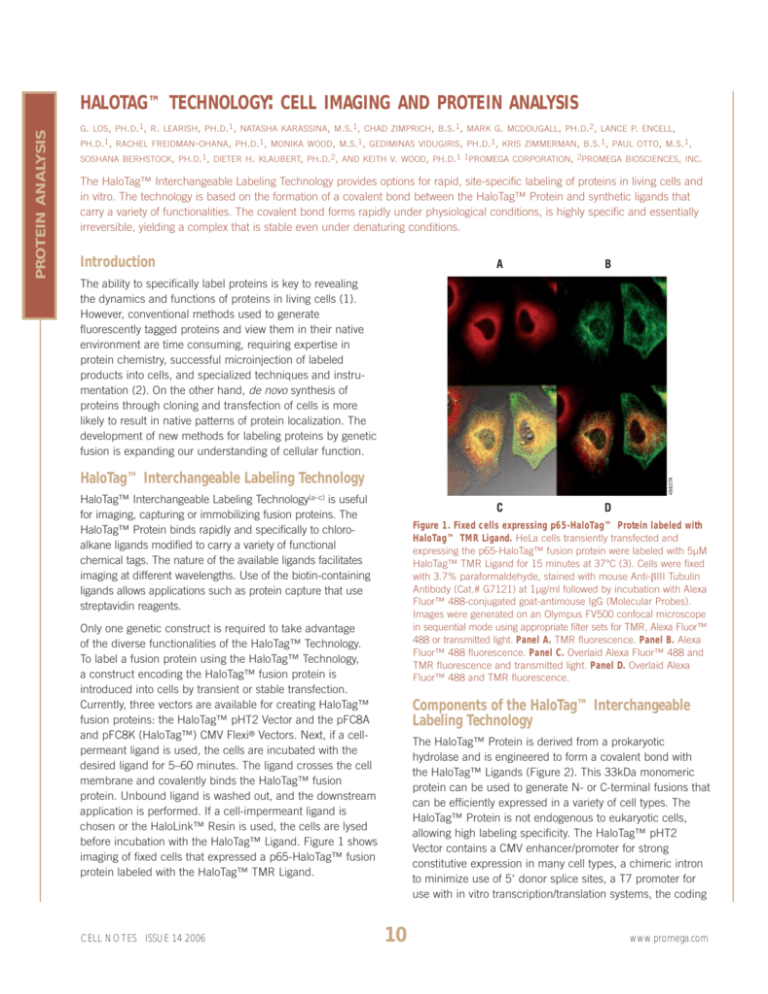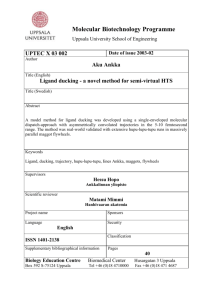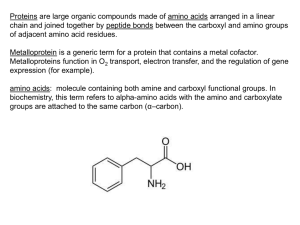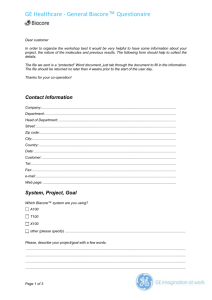HaloTag™ Technology Cell Imaging and Protein Analysis
advertisement

G. LOS, PH.D.1, R. LEARISH, PH.D.1, NATASHA KARASSINA, M.S.1, CHAD ZIMPRICH, B.S.1, MARK G. MCDOUGALL, PH.D.2, LANCE P. ENCELL, PH.D.1, RACHEL FREIDMAN-OHANA, PH.D.1, MONIKA WOOD, M.S.1, GEDIMINAS VIDUGIRIS, PH.D.1, KRIS ZIMMERMAN, B.S.1, PAUL OTTO, M.S.1, SOSHANA BERHSTOCK, PH.D.1, DIETER H. KLAUBERT, PH.D.2, AND KEITH V. WOOD, PH.D.1 1PROMEGA CORPORATION, 2PROMEGA BIOSCIENCES, INC. The HaloTag™ Interchangeable Labeling Technology provides options for rapid, site-specific labeling of proteins in living cells and in vitro. The technology is based on the formation of a covalent bond between the HaloTag™ Protein and synthetic ligands that carry a variety of functionalities. The covalent bond forms rapidly under physiological conditions, is highly specific and essentially irreversible, yielding a complex that is stable even under denaturing conditions. Introduction A B C D The ability to specifically label proteins is key to revealing the dynamics and functions of proteins in living cells (1). However, conventional methods used to generate fluorescently tagged proteins and view them in their native environment are time consuming, requiring expertise in protein chemistry, successful microinjection of labeled products into cells, and specialized techniques and instrumentation (2). On the other hand, de novo synthesis of proteins through cloning and transfection of cells is more likely to result in native patterns of protein localization. The development of new methods for labeling proteins by genetic fusion is expanding our understanding of cellular function. HaloTag™ Interchangeable Labeling Technology 4883TA PROTEIN ANALYSIS HALOTAG™ TECHNOLOGY: CELL IMAGING AND PROTEIN ANALYSIS HaloTag™ Interchangeable Labeling Technology(a–c) is useful for imaging, capturing or immobilizing fusion proteins. The HaloTag™ Protein binds rapidly and specifically to chloroalkane ligands modified to carry a variety of functional chemical tags. The nature of the available ligands facilitates imaging at different wavelengths. Use of the biotin-containing ligands allows applications such as protein capture that use streptavidin reagents. Figure 1. Fixed cells expressing p65-HaloTag™ Protein labeled with HaloTag™ TMR Ligand. HeLa cells transiently transfected and expressing the p65-HaloTag™ fusion protein were labeled with 5µM HaloTag™ TMR Ligand for 15 minutes at 37°C (3). Cells were fixed with 3.7% paraformaldehyde, stained with mouse Anti-βIII Tubulin Antibody (Cat.# G7121) at 1µg/ml followed by incubation with Alexa Fluor™ 488-conjugated goat-antimouse IgG (Molecular Probes). Images were generated on an Olympus FV500 confocal microscope in sequential mode using appropriate filter sets for TMR, Alexa Fluor™ 488 or transmitted light. Panel A. TMR fluorescence. Panel B. Alexa Fluor™ 488 fluorescence. Panel C. Overlaid Alexa Fluor™ 488 and TMR fluorescence and transmitted light. Panel D. Overlaid Alexa Fluor™ 488 and TMR fluorescence. Only one genetic construct is required to take advantage of the diverse functionalities of the HaloTag™ Technology. To label a fusion protein using the HaloTag™ Technology, a construct encoding the HaloTag™ fusion protein is introduced into cells by transient or stable transfection. Currently, three vectors are available for creating HaloTag™ fusion proteins: the HaloTag™ pHT2 Vector and the pFC8A and pFC8K (HaloTag™) CMV Flexi® Vectors. Next, if a cellpermeant ligand is used, the cells are incubated with the desired ligand for 5–60 minutes. The ligand crosses the cell membrane and covalently binds the HaloTag™ fusion protein. Unbound ligand is washed out, and the downstream application is performed. If a cell-impermeant ligand is chosen or the HaloLink™ Resin is used, the cells are lysed before incubation with the HaloTag™ Ligand. Figure 1 shows imaging of fixed cells that expressed a p65-HaloTag™ fusion protein labeled with the HaloTag™ TMR Ligand. CELL NOTES ISSUE 14 2006 Components of the HaloTag™ Interchangeable Labeling Technology The HaloTag™ Protein is derived from a prokaryotic hydrolase and is engineered to form a covalent bond with the HaloTag™ Ligands (Figure 2). This 33kDa monomeric protein can be used to generate N- or C-terminal fusions that can be efficiently expressed in a variety of cell types. The HaloTag™ Protein is not endogenous to eukaryotic cells, allowing high labeling specificity. The HaloTag™ pHT2 Vector contains a CMV enhancer/promoter for strong constitutive expression in many cell types, a chimeric intron to minimize use of 5′ donor splice sites, a T7 promoter for use with in vitro transcription/translation systems, the coding 10 www.promega.com Cell Imaging and Protein Analysis Functional Reporter N-terminus O + N – HaloTag™ TMR Ligand 555Ex/585Em C35H42CIN3O6 MW = 636 O2C O Reactive Linker N H O O 4787TB HaloTag™ diAcFAM Ligand 494Ex/526Em (after hydrolysis) C35H36CINO10 MW = 666 HaloTag™ Coumarin Ligand 353Ex/434Em C22H31CIN2O5 MW = 439 sequence for the HaloTag™ Protein and an SV40 late polyadenylation signal (3). The pFC8A and pFC8K (HaloTag™) CMV Flexi® Vectors contain these features along with a Factor Xa cleavage site that can be used for purifying proteins that specifically interact with the HaloTag™ fusion partner (reference 4 and page 7 this issue). The HaloTag™ Protein can be fused to a protein or target sequence that directs the fusion protein to a specific subcellular compartment. To demonstrate this, we created two sets of expression vectors to deliver either the HaloTag™ reporter protein or humanized Monster Green® Fluorescent Protein (hMGFP) to different subcellular compartments. In the first experiment, three repeats of a nuclear localization sequence [(NLS)3] were added to the C-terminus of both the HaloTag™ Protein and hMGFP. We also created proteins www.promega.com O Cl O O O O O H2N N H O O Cl N H O O Cl N H O O Cl N H O O Cl OO HN O NH O Spacer S H N NH O O O O O O O HaloTag™ PEG-Biotin Ligand C31H57CIN4O9S MW = 697 Figure 3. Structure of the HaloTag™ Ligands. All of the currently available ligands, with the exception of the HaloTag™ PEG-Biotin Ligand, readily cross the cell membrane. targeted to the cytoplasm by fusing the α-tubulin gene to the C-terminus of each reporter protein. HeLa cells were transiently cotransfected with either HaloTag-(NLS)3 plus hMGFP-α-tubulin or HaloTag™-α-tubulin plus hMGFP(NLS)3. Cells were incubated with either the HaloTag™-TMR Ligand or the HaloTag™ Coumarin Ligand, and live-cell images were captured (Figure 4). The HaloTag™ Ligand labeling was localized to the nucleus in the HaloTag™-(NLS)3transfected cells. This pattern was present in cells containing both the coumarin ligand- and the TMR ligand-labeled HaloTag™ fusion proteins (Figure 4, Panels A and C). Not surprisingly, a low level of cytoplasmic HaloTag™ signal was also detected in some cells (Figure 4, Panel A), which may represent protein being translocated to the nucleus. In contrast, in both TMR and Coumarin Ligand-labeled cells, the intrinsic green fluorescence of cotransfected hMGFP-αtubulin fusion protein was confined to the cytoplasm (Figure 4, Panels B and D). The HaloTag™-α-tubulin fusion protein was also localized to the cytoplasm, as demonstrated by labeling with the TMR Ligand (Figure 4, Panel E). Thus both α-tubulin fusion reporters were expressed in the expected location for the native cytoskeletal protein. The localized, intrinsic green fluorescence of the expressed hMGFP-(NLS)3 11 CELL NOTES ISSUE 14 2006 PROTEIN ANALYSIS The HaloTag™ Ligands contain two crucial components: 1) a common HaloTag™ Reactive Linker that initiates formation of a covalent bond with the HaloTag™ Protein, and 2) a functional reporter such as the fluorescent dyes TMR, diAcFAM and Coumarin (Figure 3). The rate of HaloTag™ Ligand binding to the HaloTag™ Protein is remarkably fast. Fluorescent polarization analysis using a purified GSTHaloTag™ fusion protein shows that the HaloTag™ TMR Ligand binding kinetics in vitro are similar to that for TMRbiotin binding to streptavidin (5), which is similar to the biotinstreptavidin interaction (6). The HaloTag™ Ligands show no detectable cellular toxicity or morphological side effects under the labeling conditions described in the Technical Manual (3). O S HaloTag™ Biotin Ligand C20H36CIN3O4S MW = 450 HN Live-Cell Imaging and Subcellular Localization O O C-terminus Figure 2. Molecular model of the HaloTag™ Protein with a covalently bound HaloTag™ TMR Ligand. Overview of the protein structure (top right) with close-up of the ligand tunnel outlined by a mesh Connolly surface (left). The HaloTag™ TMR Ligand (fluorescent moiety in red, reactive linker in orange) is shown covalently bound to the aspartate nucleophile (shown in blue). Replacement of the catalytic base (His) with Phe (also shown in blue) renders the HaloTag™ Protein inactive by impairing its ability to hydrolyze the ester intermediate, leading to the formation of a stable covalent bond. N 5515MA HaloTag™ TMR Ligand Cell Imaging and Protein Analysis B. 0 minutes 4 hours 20 minutes C. D. 4 hours 40 minutes E. F. 5 hours 20 minutes 6 hours 20 minutes 4990TA Figure 4. Targeting HaloTag™ and hMGFP reporters to the nucleus or cytoplasm of live cells. HeLa cells were transiently cotransfected with either HaloTag™-(NLS)3 plus hMGFP-α-tubulin (Panels A–D) or HaloTag™-α-tubulin plus hMGFP-(NLS)3 (Panels E and F). Twentyfour hours later, cells expressing HaloTag™ Protein were incubated with either 25µM Coumarin Ligand (Panels A and B) or 5µM HaloTag™ TMR Ligand (Panels C and D) for 15 minutes; cells expressing HaloTag™-α-tubulin were incubated wtih 5µM HaloTag™ TMR Ligand for 15 minutes at 37°C/5% CO2 (Panels E and F). Cells were washed and incubated for 30 minutes. In Panels A and B, cells were imaged with an Olympus IX81 epifluorescent microscope equipped with Chroma filter sets (#31000 DAPI for the Coumarin Ligand and #41001FITC for hMGFP), a Hamamatsu Orca CCD camera and environmental controls. Images in Panels C–F were captured with sequential two-laser scanning and filters appropriate for TMR and FITC fluorescence. 6 hours 40 minutes 7 hours 8 hours 20 minutes 4884TA PROTEIN ANALYSIS A. construct demonstrates that the hMGFP was successfully targeted to the the nucleus. These data demonstrate that the HaloTag™ Technology can be used to localize proteins to subcellular structures in live-cell imaging studies and that HaloTag™ Technology can be used along with intrinsically fluorescent proteins for multicolor imaging experiments. Figure 5. Time-lapse images of HeLa cells expressing the p65HaloTag™ fusion protein. HeLa cells transiently transfected with plasmid encoding the p65-HaloTag™ fusion protein were labeled with 5µM HaloTag™ TMR Ligand for 15 minutes at 37°C (3). Images were generated on an Olympus FV500 confocal microscope using filter sets for TMR or transmitted light. Images were collected every 20 minutes for 8 hours and 20 minutes. The HaloTag™ Ligands and expression of the HaloTag™ Protein have shown no detectable toxicity or morphological side effects using the recommended labeling conditions in the cell lines tested (e.g., HeLa and CHO-K1). This allows live-cell imaging over long periods of time, enabling study of phenomena such as the cell cycle, cell differentiation and long-term effects of drugs. nonstimulated cells through the binding of specific NF-κB inhibitors, IκB proteins (7–9). Cells transfected with a p65HaloTag™ fusion protein were labeled and images were taken every 20 minutes for 8 hours and 20 minutes (Figure 5). The cells have unaltered morphology at all time points examined, and staining is absent from the nucleus, as expected for nonstimulated cells. Importantly, expression of the p65HaloTag™ TMR Ligand has no effect on complex cellular functions. For example, the time-lapse images in Figure 5 clearly show a cell in the process of dividing (arrow). The p65 protein is a member of the eukaryotic nuclear factor κB (NF-κB) protein family. NF-κB proteins contain a nuclear localization sequence (NLS), which is rendered inactive in CELL NOTES ISSUE 14 2006 12 www.promega.com Cell Imaging and Protein Analysis A. A. B. C. D. E. F. D. Figure 6. Pulse-chase labeling of p65-HaloTag™-FLAG fusion protein. HeLa cells were transiently transfected with vector encoding the p65HaloTag™-FLAG fusion protein. Cells were labeled with HaloTag™ TMR Ligand 24 hours post-transfection (5µM, 15 minutes, 37ºC; Panel A). Unbound ligand was washed out and cells maintained under standard conditions for 18 hours. Cells were labeled with HaloTag™ diAcFAM Ligand (1µM, 30 minutes, 37ºC; Panel B) and imaged on an Olympus FV500 confocal microscope in sequential mode using appropriate TMR and FAM filter sets or transmitted light. Panel C transmitted light; Panel D, overlaid TMR and FAM fluorescence. Figure 7. Multiplexing HaloTag™ labeling and immunocytochemistry. HeLa cells were transfected with HaloTag™-α-tubulin, labeled with HaloTag™ diAcFAM (Panels A–C) or TMR Ligands (Panels D–F), washed and fixed as described in Figure 1. Cells were permeabilized with 0.1% Triton®-X 100 and immunolabeled with Anti-βIII Tubulin mAb (1:5,000 dilution, Cat.# G7121). Cells were incubated with 1:500 dilutions of Alexa Fluor™ 488-conjugated secondary antibody (Panels A–C) or Cy®3-conjugated secondary antibody (Panels D–F). Panels A and D show cells labeled with the HaloTag™ Ligands only. Panel A, diAcFam; Panel D, TMR. Panels B and E show labeling for βIII tubulin. Panels C and F show double staining for the HaloTag™ Protein and βIII tubulin. Differential Labeling: Pulse-Chase Experiments ligand treated C UB B The flexible nature of the HaloTag™ Technology allows labeling of different protein pools with a variety of HaloTag™ Ligands and separating these pools by imaging cells at different wavelengths (imaging-based pulse-chase experiments). To demonstrate this application, we labeled cells expressing the p65-HaloTag™-FLAG fusion protein with the HaloTag™ TMR Ligand (pulse). Unbound ligand was washed out, and cells were maintained in standard growth conditions. Cells were labeled with the HaloTag™ diAcFAM Ligand 18 hours later and imaged. www.promega.com ligand treated C UB B control C UB B 98 – 64 – 36 – p65-Ab IκB-Ab Figure 8. Efficient capture of a p65-HaloTag™ fusion protein and cocapture of IκB on streptavidin-coated paramagnetic particles (SA PMPs). CHO-K1 cells expressing the p65-HaloTag™ fusion protein were incubated with or without 25µM HaloTag™ Biotin Ligand. Cells were lysed, and biotin-labeled proteins were captured on SA PMPs (Cat.# Z5481). Proteins were resolved by SDS-PAGE and analyzed by Western blot with anti-p65 antibody (BD Biosciences, Panel A) or antiIκB antibody (BD Biosciences, Panel B). Content of lanes for both panels: C = cell lysate, UB = unbound protein, B = bound protein. Fixed-Cell Imaging with HaloTag™ Technology HaloTag™ Ligands retain their fluorescent properties after fixation, allowing the possibility of performing multiplexing experiments that employ immunocytochemistry (ICC, 10). We labeled cells expressing HaloTag™-α-tubulin with the TMR Ligand or the diAcFAM Ligand and processed the cells for ICC using a primary antibody against βIII-tubulin and Alexa Fluor™ 488- or Cy®3-conjugated secondary antibodies. All HeLa cells expressed βIII-tubulin in the cytoplasm (Figure 7). 13 CELL NOTES ISSUE 14 2006 PROTEIN ANALYSIS Two pools of fluorescently labeled proteins were detected (Figure 6). The first protein pool was labeled with the TMR Ligand and was present in cells at time zero. The second pool was labeled with the diAcFAM Ligand and represents protein synthesized during the 18-hour incubation (Figure 6, Panel B). The intensity of TMR and FAM signals, and therefore the size of “old” and “new” protein pools vary in cells, reflecting cell-to-cell variability of protein synthesis and degradation in transiently transfected cells. No FAM labeling was detected if the diAcFAM Ligand was added to the cells immediately after washing the unbound TMR Ligand from the cells (data not shown). These data demonstrate that differential labeling of protein pools (i.e., pulse-chase experiments) may be used to analyze protein synthesis, degradation, subcellular distribution and stimuli-dependent translocation of proteins in living cells. control C UB B 4886TA 5729TA 4986TA C. B. PROTEIN ANALYSIS Cell Imaging and Protein Analysis is required to capture the p65-HaloTag™ protein (Figure 8, Panel A). Moreover, the immobilized p65-HaloTag™ Protein was able to capture and pull down its specific interacting partner, IκB (Figure 8, Panel B). The HaloTag™-α-tubulin reporter was localized to the cytoplasm in a subpopulation of transfected cells. This observation was similar for both fluorophore combinations. These observations demonstrate the utility of two-color imaging using HaloTag™ Technology and ICC to label distinct cytoplasmic proteins. Summary The ability to label and analyze proteins in their native environment is critical to developing a detailed understanding of biological pathways and cellular function. The newly developed HaloTag™ Interchangeable Labeling Technology is a flexible system that enables the efficient labeling of fusion proteins directly in living cells and in vitro. Fluorescently labeled HaloTag™ fusion proteins can be imaged in either live- or fixed-cell preparations. This capability allows researchers to examine protein translocation in real time and multiplex the HaloTag™ Technology with different immunocytochemical techniques for high-content analysis. Furthermore, because the HaloTag™ Protein-Ligand interaction is so stable, labeled fusion proteins can be analyzed directly using SDS-PAGE. Lastly, the HaloTag™ Technology is an important tool for exploring protein:protein interations. ■ Gel Analysis of HaloTag™-Based Fusion Proteins The HaloTag™ Protein-Ligand interaction is stable and highly specific. The fluorescently labeled HaloTag™ Protein can be boiled with SDS-PAGE sample buffer and resolved by SDSPAGE without detectable loss of the fluorescent signal (11). Analyses of HaloTag™ Protein can be combined with other techniques such as Western blot. Additionally the HaloTag™ Technology can be used to capture HaloTag™ fusion proteins expressed in mammalian cells. CHO-K1 cells were transiently transfected with a construct encoding the p65-HaloTag™ fusion protein and incubated with the HaloTag™ Biotin Ligand. Cell lysates were incubated with Streptavidin MagneSphere® Paramagnetic Particles to capture the biotin-labeled fusion protein. Proteins were resovled by SDS-PAGE and analyzed by Western blot. As expected both control and ligand-treated cells express the fusion protein (Figure 8, Panel A). However ligand References Ordering Information 1. Giuliamo, K.A. and Taylor, D.L. (1998) Trends. Biotechnol. 16, 135–40. Product Size Cat.# HaloTag™ pHT2 Vector 20µg G8241 2. Chapman-Smith, A. and Cronan, J.E. (1999) Trends Biochem. Sci. 24, 359–63. pFC8A (HaloTag™) CMV Flexi® Vector 20µg C3631 pFC8K (HaloTag™) CMV Flexi® Vector 20µg C3641 3. HaloTag™ Interchangeable Protein Labeling Technology Technical Manual #TM240, Promega Corporation. HaloTag™ TMR Ligand 30µl G8251 HaloTag™ diAcFam Ligand 30µl G8271 4. Urh, M. et al. (2005) Promega Notes 92, 24–9. HaloTag™ Coumarin Ligand 30µl G8581 5. Los, G. (2005) Cell Notes 11, 2–6. HaloTag™ Biotin Ligand 30µl G8281 6. Quershi, M.H. et al. (2001) J. Biol. Chem. 276, 46422–8. HaloTag™ PEG Biotin Ligand 30µl G8591 7. Ghosh, S., May, M.J. and Kopp, E.B. (1998) Ann. Rev. Immunol. 16, 225–60. HaloLink™ Resin 2ml G1911 5ml G1912 8. Karin, M., Yamamoto, Y. and Wang, Q.M. (2004) Nat. Rev. Drug Discov. 3, 17–26. (a)Patent 9. Burnstein, E and Duckett, C.S. (2003) Curr. Opin. Cell Biol. 15, 732–7 (b)For 10. Los, G. et al. (2005) Promega Notes 89, 2–5. Pending. For research use only. With respect to manufacture or sale of research products, or any diagnostic, therapeutic or prophylactic uses, please contact Promega for supply and licensing information. research use only. Persons wishing to use this product or its derivatives in other fields of use, including without limitation, commercial sale, diagnostics or therapeutics, should contact Promega Corporation for licensing information. (c)The CMV promoter and its use are covered under U.S. Pat. Nos. 5,168,062 and 5,385,839 owned by the University of Iowa Research Foundation, Iowa City, Iowa, and licensed FOR RESEARCH USE ONLY. Research Use includes contract research for which monetary or other consideration may be received. Other commercial users must obtain a license to these patents directly from the University of Iowa Research Foundation. Protocols HaloTag™ Interchangeable Labeling Technology Technical Manual #TM260, Promega Corporation (www.promega.com/tbs/tm260/tm260.html) Flexi and Monster Green are registered trademarks of Promega Corporation. HaloLink and HaloTag are trademarks of Promega Corporation. Products may be covered by pending or issued patents or may have certain limitations. Please visit our Web site for more information. Online Animation Alexa Fluor is a trademark of Molecular Probes, Inc. Cy and Sepharose are registered trademarks of Amersham Biosciences, Ltd. Triton is a registered trademark of Union Carbide Chemicals and Plastics Technology corporation HaloTag™ Interchangeable Labeling Technology (www.promega.com/paguide/animation/ selector.htm?coreName=halotag01) CELL NOTES ISSUE 14 2006 14 www.promega.com





